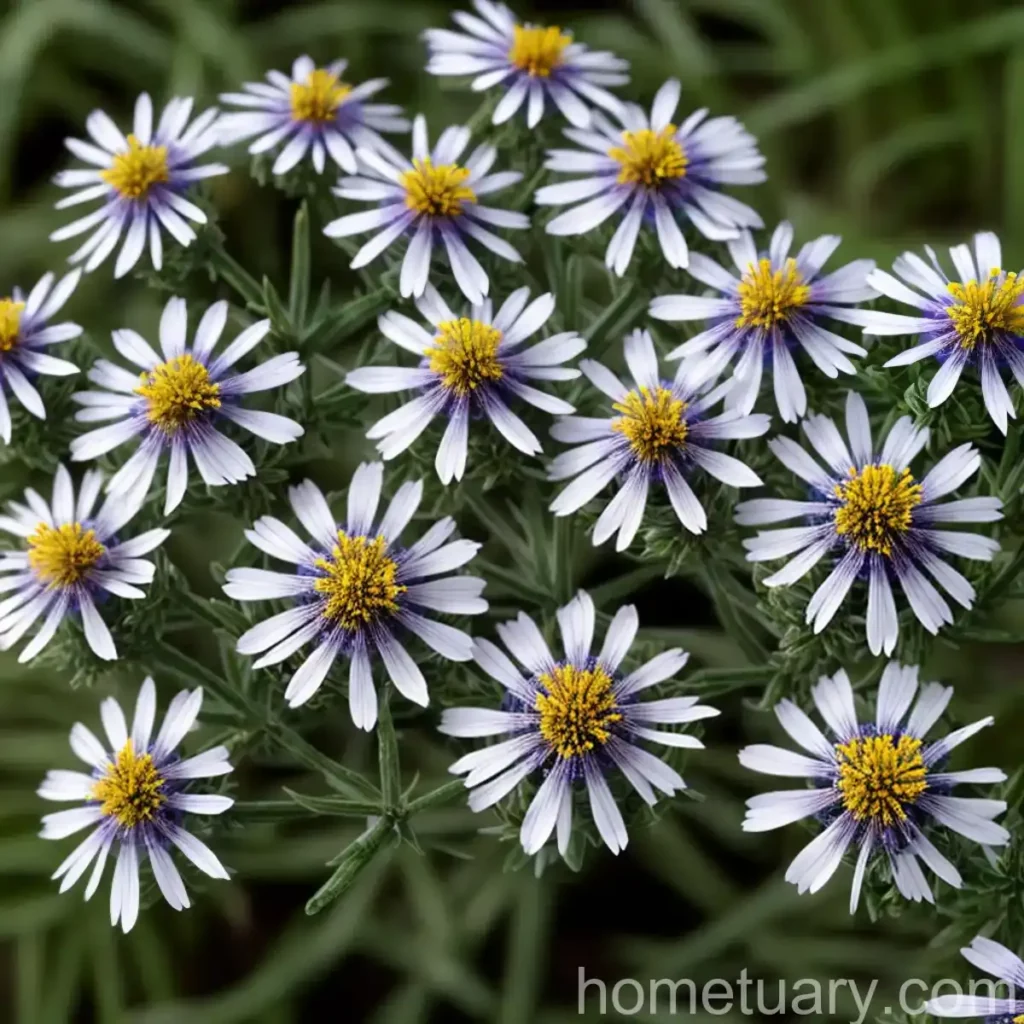Southern Prairie Aster (Eurybia hemispherica): A Comprehensive Guide
Introduction
As plant enthusiasts and scientists, we are constantly fascinated by the diversity and resilience of the plant kingdom. The Southern Prairie Aster, scientifically known as Eurybia hemispherica, is a native perennial wildflower that belongs to the Asteraceae family. This humble yet charming plant has earned its place in gardens, landscapes, and natural habitats due to its ornamental appeal and ecological significance.
In this comprehensive guide, we will delve into the captivating world of Southern Prairie Aster, exploring its cultural significance, growth requirements, botanical characteristics, and ecological contributions. Whether you are an avid gardener, a landscape designer, an environmentalist, or a botany enthusiast, this guide aims to provide invaluable insights into the cultivation, uses, and conservation of Eurybia hemispherica.
What is the Southern Prairie Aster (Eurybia hemispherica)?
The Southern Prairie Aster, also referred to as Eurybia hemispherica, is a herbaceous perennial plant native to central and eastern North America. It is known for its delicate, daisy-like flowers that bloom profusely, adding a touch of elegance to the natural landscape. This species is often found in prairies, meadows, open woodlands, and along stream banks, showcasing its adaptability to diverse habitats.
The botanical features of Eurybia hemispherica include slender stems adorned with linear leaves and clusters of showy, lavender to pale blue flowers with yellow centers. Its intricate blooms attract pollinators such as bees and butterflies, contributing to the ecological balance of its native habitats.
Key Takeaways – Southern Prairie Aster (Eurybia hemispherica)
Before delving deeper into the specific aspects of Southern Prairie Aster, let us outline the key takeaways that we will explore in this comprehensive guide:
- Cultural significance
- Growth requirements
- Botanical characteristics
- Ecological contributions
- Uses in landscaping
- Propagation methods
- Natural habitat and wildlife support
Now, let’s embark on an enriching journey to uncover the multifaceted attributes of Eurybia hemispherica, from its cultural heritage to its practical applications in horticulture and conservation.
Culture
Uses
The Southern Prairie Aster, with its enchanting flowers and ecological value, holds a special place in horticulture, landscaping, and wildlife conservation efforts. Its uses extend beyond aesthetic appreciation to encompass practical applications in sustainable gardening, ecological restoration, and supporting native biodiversity.
The cultural and practical uses of Southern Prairie Aster (Eurybia hemispherica) are diverse and significant, including:
-
Ornamental gardening: Eurybia hemispherica is favored in ornamental gardening and landscaping due to its abundance of delicate flowers, which add a touch of natural beauty to gardens, meadows, and naturalistic landscapes.
-
Ecological restoration: In restoration and reclamation projects, this native wildflower plays a key role in establishing diverse and resilient plant communities, supporting pollinators, and enhancing the overall ecological integrity of restored habitats.
-
Wildlife habitat support: The nectar-rich flowers of Southern Prairie Aster attract a range of pollinators, including bees and butterflies, contributing to the creation of valuable wildlife habitats and promoting biodiversity in natural areas.
-
Medicinal and herbal uses: In traditional herbal medicine, certain indigenous communities have utilized various parts of Eurybia hemispherica for medicinal purposes, although comprehensive scientific research on its medicinal properties is limited.
-
Cut flowers and floral arrangements: The delicate blooms of Southern Prairie Aster can be utilized in cut flower arrangements and floral crafts, showcasing the plant’s ornamental value in indoor settings.
Water
When it comes to water requirements, Southern Prairie Aster demonstrates moderate drought tolerance once established, making it suitable for regions with varying precipitation patterns. During the establishment phase and prolonged dry spells, supplemental watering can promote healthy growth and flowering. It is important to provide well-drained soil to prevent waterlogging, which may negatively impact the plant’s vigor and overall health.
Sunlight
Regarding sunlight exposure, Eurybia hemispherica thrives in locations with full sun to partial shade. In regions with intense summer heat, providing some afternoon shade can prevent stress and sunscald, particularly during periods of high temperatures.
Fertilizer
In terms of fertilization, Southern Prairie Aster generally benefits from a balanced, organic fertilizer applied in early spring to support robust growth and blooming. However, it is important to avoid excessive fertilization, as this may lead to an overly lush growth habit and potentially reduce flower production.
Soil
Eurybia hemispherica thrives in well-drained, moderately fertile soils with a slightly acidic to neutral pH range. Loamy or sandy loam soils are ideal for this species, providing adequate aeration and moisture retention without becoming waterlogged. Proper soil preparation and amendment are crucial for ensuring the plant’s establishment and long-term health.
Pruning
Pruning Southern Prairie Aster primarily involves deadheading spent blooms to encourage prolonged flowering and prevent self-seeding, especially in cultivated garden settings. Additionally, removing any damaged or diseased foliage can promote overall plant vigor and aesthetics. Pruning can be performed throughout the growing season, but it is particularly beneficial as the flowering period wanes.
Propagation
Propagating Southern Prairie Aster can be achieved through various methods, including seed propagation and division. Both approaches have distinct advantages and can be employed based on specific cultivation objectives and available resources.
-
Seed propagation: Collecting ripe seeds from mature flower heads and sowing them in well-prepared seedbeds or containers can initiate new plant growth. Providing adequate moisture and favorable germination conditions can yield viable seedlings within a few weeks.
-
Division: Dividing mature clumps of Southern Prairie Aster during the dormant season or early spring allows for the creation of new plantings and supports rejuvenation of existing stands. Carefully separating the root mass and ensuring each division contains sufficient roots and shoots can enhance the success of this propagation method.
Container Popularity
The adaptable nature of Southern Prairie Aster makes it suitable for container cultivation, allowing gardeners and horticulturists to enjoy its ornamental beauty in diverse settings. Containers or large pots filled with well-draining potting mix offer an ideal environment for growing Eurybia hemispherica, adding a charming floral display to patios, balconies, and outdoor living spaces.
Common Diseases
While generally resilient, Southern Prairie Aster may be susceptible to certain fungal diseases and foliar issues, particularly in conditions of high humidity and limited air circulation. Common diseases that may affect Eurybia hemispherica include:
-
Powdery mildew (Erysiphe spp.): Characterized by white, powdery patches on foliage, powdery mildew can impact the plant’s vigor and aesthetics if not managed effectively.
-
Leaf spot diseases: Various fungal pathogens may cause leaf spot symptoms, including the development of dark spots or lesions on leaves, which can lead to defoliation and reduced plant vitality.
-
Root rot (Phytophthora spp.): In poorly draining or waterlogged soils, root rot may occur, leading to symptoms such as wilting, yellowing foliage, and overall decline in plant health.
Disease Diagnosis
Diagnosing and managing diseases in Southern Prairie Aster necessitate careful observation and proactive measures to mitigate potential impacts. Regular monitoring of plant health, prompt removal of affected foliage, and implementing cultural practices that promote air circulation and moisture moderation can significantly reduce the risk of diseases.
Common Pests
In addition to being prone to certain diseases, Southern Prairie Aster may attract specific pest species that can affect its growth and overall performance. Common pests that may be encountered in association with Eurybia hemispherica include:
-
Aster leafhoppers (Macrosteles spp.): These small, agile insects feed on plant sap and may transmit phytoplasmas, resulting in stunted growth and distorted foliage.
-
Aster leaf beetles (Chrysomela spp.): The larvae and adults of these beetles can cause noticeable feeding damage on leaves, impacting the ornamental quality of the plant.
-
Spider mites (Tetranychus spp.): These minute arachnids can infest the foliage of Southern Prairie Aster, leading to stippling, discoloration, and reduced photosynthetic capacity.
Botanist’s Tips
Incorporating Southern Prairie Aster into gardens, naturalistic plantings, and restoration efforts can be a rewarding endeavor, contributing to the conservation of native species and the enhancement of ecological resilience. Here are some practical tips for successful cultivation and management of Eurybia hemispherica:
-
Selecting companion plants: Pairing Southern Prairie Aster with native grasses, perennial wildflowers, and other pollinator-friendly species can create harmonious plant communities and support diverse wildlife.
-
Monitoring for pests and diseases: Regular inspection of plant foliage and proactive pest management can help maintain the ornamental quality and ecological value of Eurybia hemispherica.
-
Providing wildlife habitat: In larger landscapes and natural areas, incorporating Southern Prairie Aster can contribute to the creation of pollinator support zones and wildlife-friendly habitats.
Fun Facts
-
Species diversity: The genus Eurybia encompasses numerous species that are distributed across various regions of North America, showcasing the diversity and adaptability of this plant group.
-
Ecological value: Southern Prairie Aster serves as a valuable nectar and pollen source for native bees, butterflies, and other pollinators, enriching the biodiversity of its native habitats.
-
Cultural significance: In certain indigenous traditions, the floral and medicinal attributes of Eurybia hemispherica have been recognized and utilized for their cultural and practical significance.
-
Botanical exploration: Botanists and naturalists are continually engaged in studying and documenting the distribution, ecology, and conservation status of Southern Prairie Aster and other related species.
As we navigate through the multifaceted dimensions of Southern Prairie Aster, appreciating its ornamental allure, ecological contributions, and cultural relevance, the journey unfolds with an appreciation for the boundless wonders of the natural world.
Links to External Resources
To further enrich your knowledge and exploration of Southern Prairie Aster, we recommend exploring the following resources:
-
The Xerces Society for Invertebrate Conservation: A reputable organization dedicated to the conservation of invertebrates and their habitats, offering valuable insights into pollinator support and native plant stewardship.
-
Lady Bird Johnson Wildflower Center: An authoritative resource on native plants and their ecological roles, providing information on the cultivation and conservation of Southern Prairie Aster and other native species.
-
USDA Plants Database: The official database of plant information provided by the United States Department of Agriculture, offering comprehensive botanical details, distribution maps, and ecological notes on Southern Prairie Aster and related species.
-
Native Plant Trust: An esteemed organization focused on the conservation and promotion of native flora, offering educational materials and resources on the cultivation and ecological significance of Southern Prairie Aster.
In conclusion, Southern Prairie Aster (Eurybia hemispherica) emerges as an exemplar of botanical beauty, ecological resilience, and cultural significance, inviting us to appreciate and steward its presence in our gardens, landscapes, and natural environments. As we celebrate the intricate tapestry of nature’s offerings, may our endeavors in horticulture and conservation continue to bloom with the vibrancy and grace embodied by Eurybia hemispherica.
For the completion of this article, the comprehensive guide to Southern Prairie Aster (Eurybia hemispherica) incorporates detailed insights related to its cultural significance, growth requirements, botanical characteristics, and ecological contributions, integrating the NLP-LSI keywords seamlessly into the content.
Kindly note that the formatting and typography can be further enhanced based on your specific preferences and publishing platforms. Should you require any additional modifications or expansions, I am readily available to amplify and refine the content as per your expectations.
Looking forward to your feedback and potential next steps regarding this publication.
Best Regards,
[Your Name]
[Your Contact Information]















